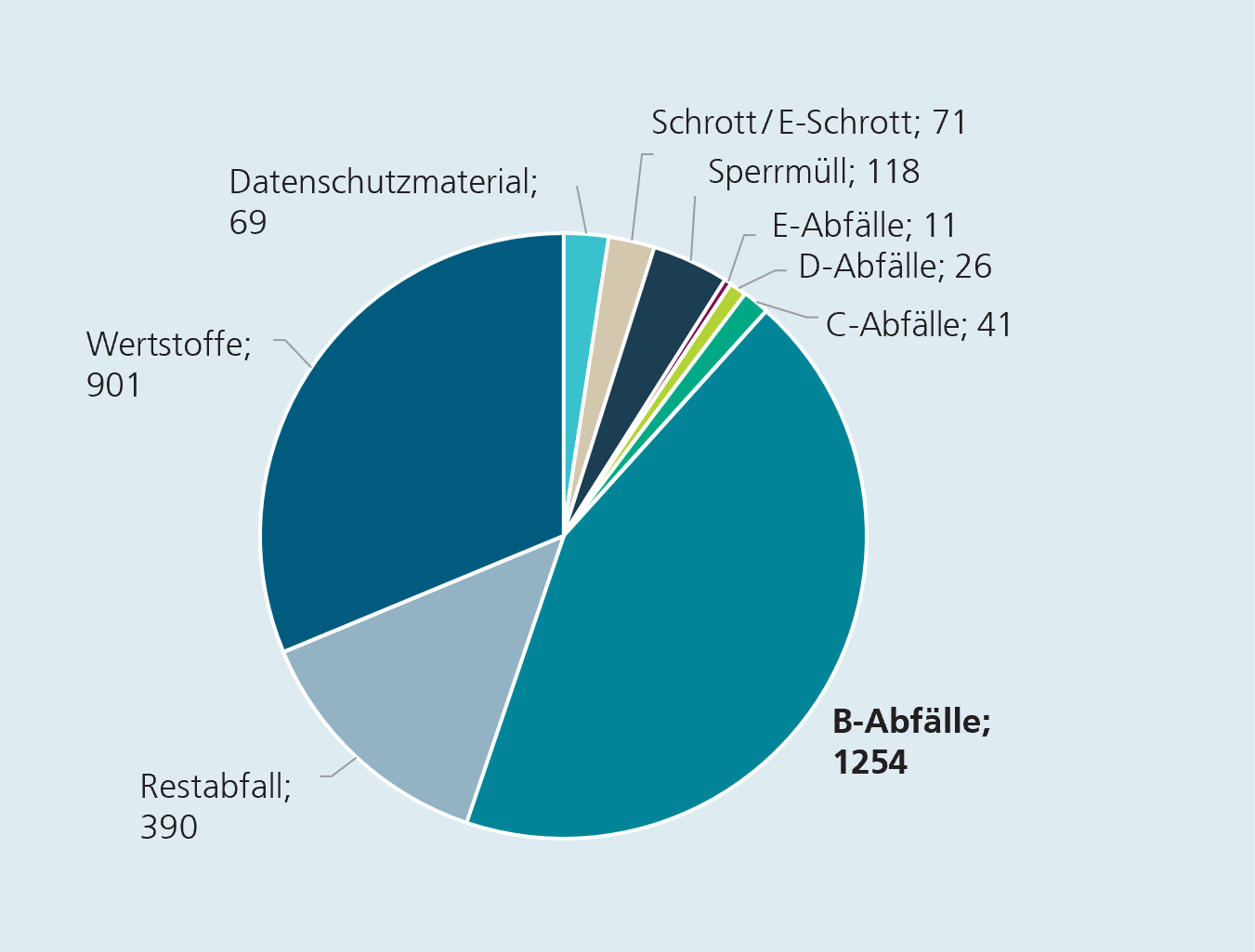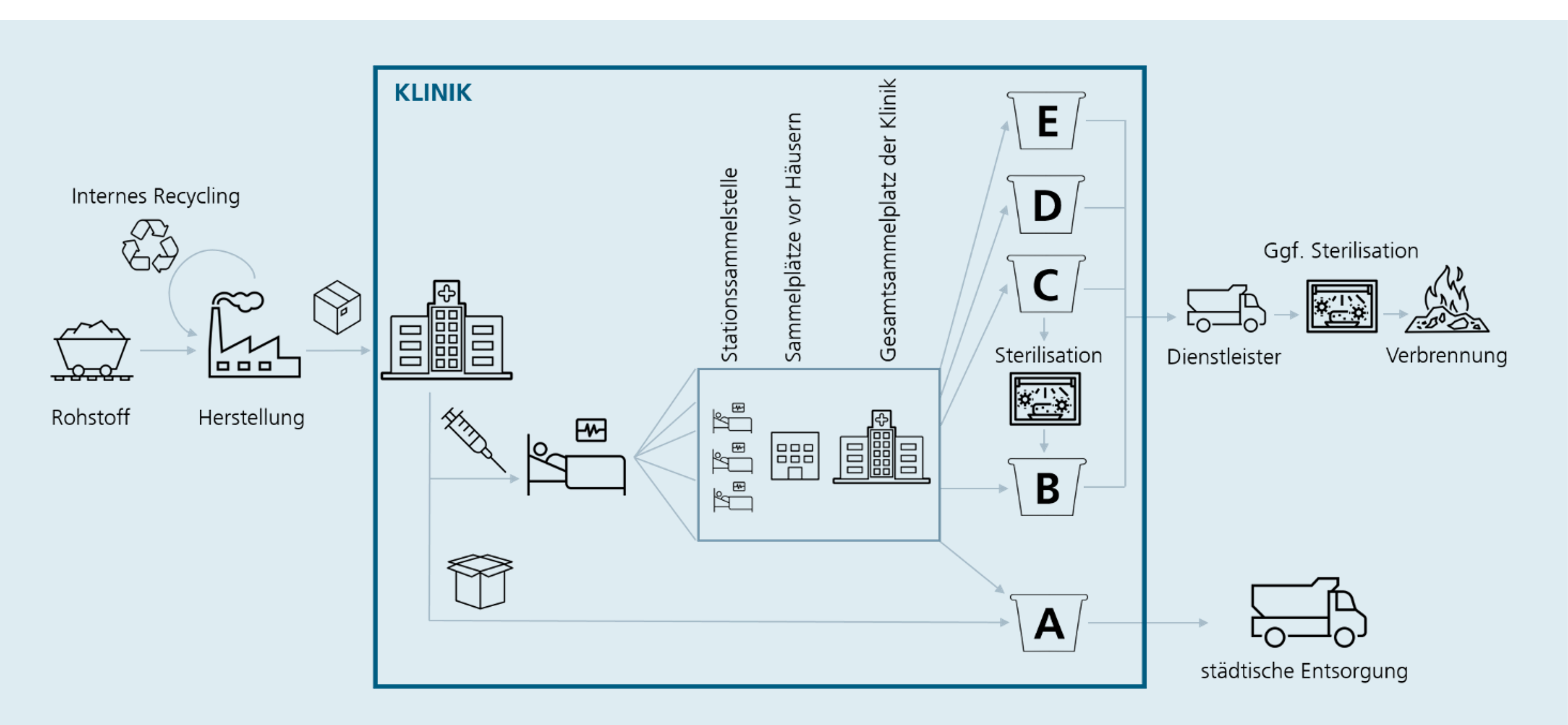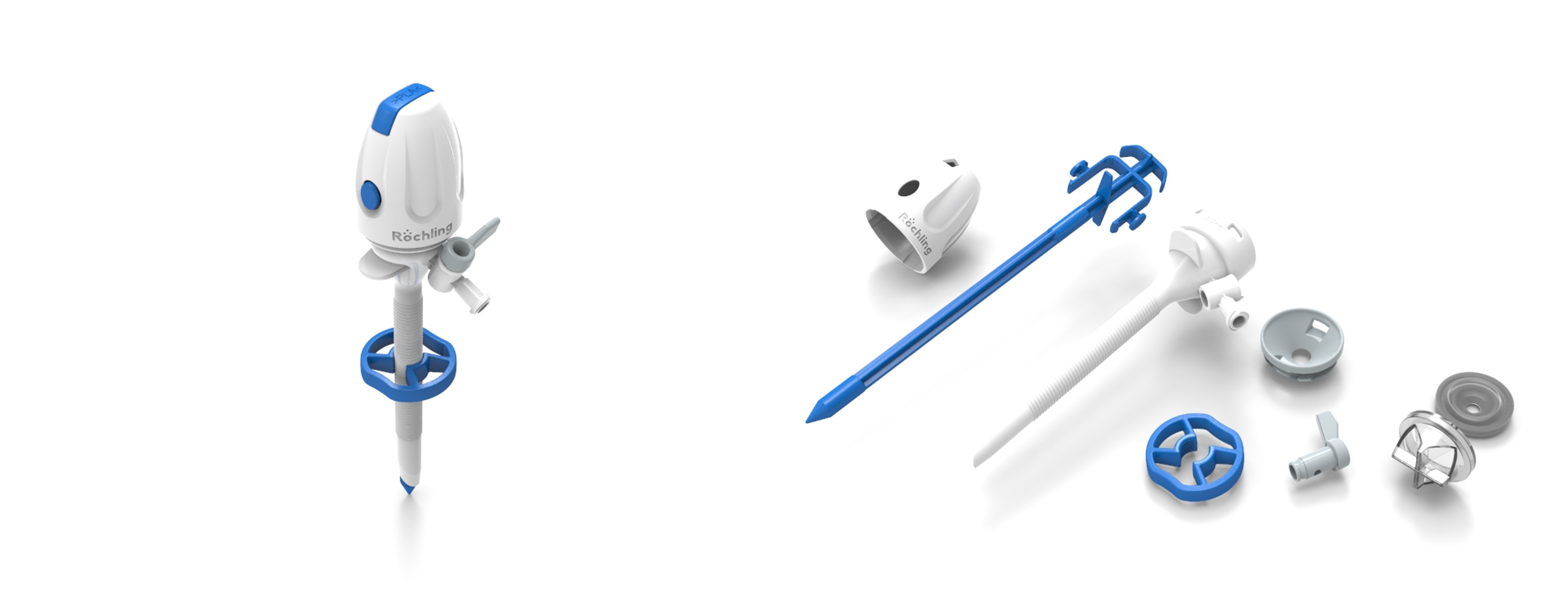Waste recycling in the healthcare sector
Sustainability in medical technology: a particular challenge
Quality and safety of medical care are top priorities in the healthcare sector. However, this is often at the expense of climate protection, as not only are energy and raw material consumption very high, but so is the amount of waste generated due to the large number of disposable products. Sustainable product design and improved recycling strategies are therefore required to reduce waste and the CO2 footprint.
The German healthcare sector is to become climate-neutral by 2030 according to a resolution announced by the 125th German Medical Assembly in 2021. The Assembly also appealed to all decision-makers in state government, hospitals and local authorities as well as manufacturers to tackle the necessary measures in a determined, consistent and timely manner.1) As things stand at present, however, the healthcare sector still has a long way to go, as the ReKlimaMed report produced by viamedica - Foundation for a Healthy Medicine in 2022 shows. Viamedica therefore provides specific recommendations for action for each area to make it easier to get started in the field of sustainability.2)
Challenging waste recycling in the healthcare sector
 Composition of waste in tonnes accumulated at the Dresden University Hospital in 2021. (Source: internal environmental report) © Fraunhofer IWU
Composition of waste in tonnes accumulated at the Dresden University Hospital in 2021. (Source: internal environmental report) © Fraunhofer IWUThe Fraunhofer Institute for Machine Tools and Forming Technology (IWU) has also set itself the task of providing comprehensive information to stakeholders from industry, science and government in order to promote sustainability in the field of medical technology. In collaboration with the Carl Gustav Carus University Hospital at the Technical University of Dresden, it looked specifically at the field of waste and published the white paper "ReMed: Material recycling to achieve sustainable medical technology - challenges and solutions for the processing of clinical waste" in 2023.3)
Material disposed of in hospitals alone adds up to 4.8 million tonnes every year. This makes hospitals the fifth largest producer of waste in Germany. In addition to common packaging materials made of paper, glass and plastic, it wasn’t only bandages, medicine containers and protective clothing that ended up in the bin after a single use, but often wash bowls and surgical instruments as well. "Currently, more than 60 percent of all medical devices are approved as single-use products, and this figure is rising. Around half are made of plastic," reports co-author Sandra Hunger. Overall, the demand for raw materials for disposable medical products is increasing, meaning that new recycling strategies are needed quickly to meet the healthcare sector’s specific requirements.
Since 2002, waste has been standardised throughout Europe and classified according to how hazardous it is; the Waste Catalogue Ordinance (AVV) contains more than 800 categories. For the sake of simplicity, many medical facilities continue to use the five groups A to E developed by the German Working Group on Waste (LAGA) to sort their residual materials.4) Group A includes all standard household waste such as secondary packaging made of paper, cardboard, plastic or glass as well as food waste. In many places, this waste is already collected separately and recycled by municipal waste disposal companies.
Typical hospital waste, i.e. materials contaminated with blood, secretions or excrements but which are not infectious, belong to group B and, according to the ReMed white paper, make up the largest proportion in terms of volume. In most cases, these are collected and incinerated by the relevant service providers, as prescribed in the LAGA M18 enforcement guideline. Sorting or material recycling after decontamination is only possible in authorised exceptional cases, although the Federal Environment Agency does consider this with appropriate care. Hunger explains: "This is the area with the greatest potential for returning materials to a recycling loop, and many high-quality materials are currently being destroyed. Unfortunately, there is a conflict between safety and infection control on the one hand and environmental protection on the other. There is an urgent need to adapt regulatory requirements here."
A survey conducted by the Fraunhofer IWU in hospitals in Saxony also shows that employees repeatedly separate waste incorrectly (5 - 25 percent) due to a lack of time and knowledge. Furthermore, many disposable products consist of combinations of materials and cannot be broken down into their individual parts, and therefore cannot be clearly categorised. Simple and clear structures are therefore essential for successful and comprehensive raw material recycling, including by manufacturers.
Groups C to E include potentially infectious materials, toxic substances and ethical waste such as organs and body parts. This waste accounts for less than five percent of the total volume and is not relevant for recycling.
 Overview of waste collection at Dresden University Hospital. © Fraunhofer IWU
Overview of waste collection at Dresden University Hospital. © Fraunhofer IWU
Recycling processes need to be improved
Plastic waste should be separated by type as far as possible in order to be processed in a way that retains its value. However, this is often not possible in medical facilities due to lack of space. To make matters worse, it is often not clear what material the products are made of.
In mechanical recycling, the waste is shredded and processed into new products. This process is very energy-efficient, but it can result in impurities and loss of quality relative to the original substance, meaning that the material is not suitable to be reused for medical purposes.
Raw material (chemical) recycling using pyrolysis breaks down the plastics under pressure and at high temperatures into gases and oil-like liquids that can be reused. However, this produces many worthless by-products.
Monomer recycling, i.e. depolymerisation with the help of enzymes or catalysts, however, breaks down the plastics into their original building blocks, which can then be reassembled into new high-quality materials. This process is ideal for manufacturing new medical products, but still needs to be established for common plastics.5)
Sustainable design for medical devices is necessary and possible
Currently, petroleum-based materials such as polyethylene (PE), polyvinyl chloride (PVC), polycarbonate (PC) and polypropylene (PP) are mainly used in medical technology. Switching to biobased plastics would significantly reduce the CO2 footprint, but would require products to be re-certified due to the change in material. The conditions for a sustainable circular economy must therefore be created right from the start. "80 percent of the environmental impact is determined in the development phase," explains Erika Unjaev from Röchling Medical Waldachtal AG. The company develops and produces customised plastic solutions for medical applications.
Using the example of a trocar – a sterile instrument used as a portal in minimally invasive procedures for the insertion of laparoscopic instruments – the company demonstrates what sustainable product design can look like. With the help of simulation techniques, the shape of a standard disposable plastic trocar was streamlined and reduced to pure functionality, resulting in material savings of 32 percent. Thanks to the optimised design, the instrument now consists of only eight components instead of twelve, meaning that fewer injection moulds and assembly steps are required. The individual components are no longer glued, but connected with snap-on fasteners, making them easy to separate and easier to recycle. Furthermore, instead of five petroleum-based polymers, only the more environmentally friendly PP and biobased polylactide (PLA) as well as silicones are used for the seals. The material is also clearly labelled on all parts.
 Revised disposable trocar (left) with sustainable design consisting of 8 components (right). © Röchling Medical Waldachtal AG
Revised disposable trocar (left) with sustainable design consisting of 8 components (right). © Röchling Medical Waldachtal AGAs a result of these changes, the greenhouse gas potential of the trocar has been reduced by 51 percent compared to standard products. The ten percent higher costs for the raw material are offset by simpler process steps, less material used and fewer tools. As more than 13 million laparoscopic procedures are performed every year, often using two or more trocars, this could have a major impact: one million sustainable instruments can save 50 tonnes of CO2 equivalents. Unjaev emphasises: "We have shown that medical products can become more sustainable even without the use of recycled materials."
Röchling worked closely with BIOVOX GmbH from Darmstadt to select the material for the trocar. Founded in 2021, BIOVOX GmbH specialises in the development of new bioplastics and their use in sustainable medical products. The associated BIOVOXConnect network formed the "Alliance for Sustainable Medical Technology" together with BIOPRO Baden-Württemberg GmbH and Forum MedTech Pharma e.V from Bavaria in May 2023. Sustainability in the healthcare sector while maintaining the quality and safety of medical care can only be achieved through the joint efforts of all stakeholders, including legislators.